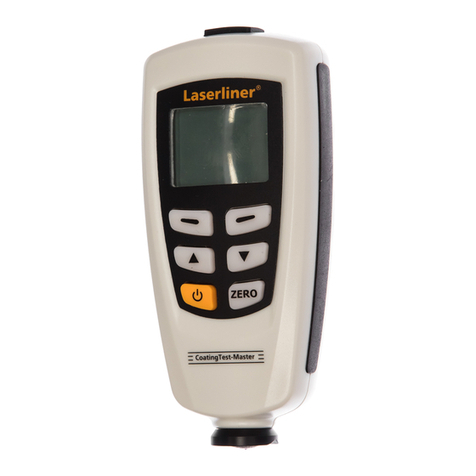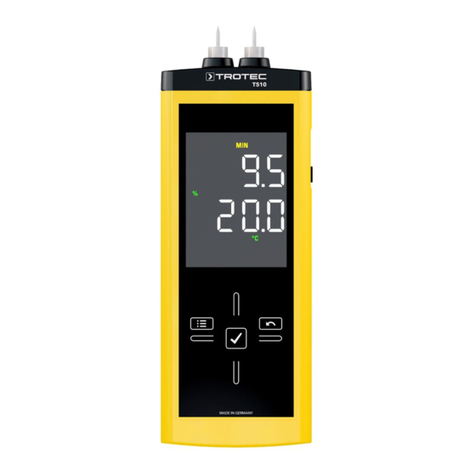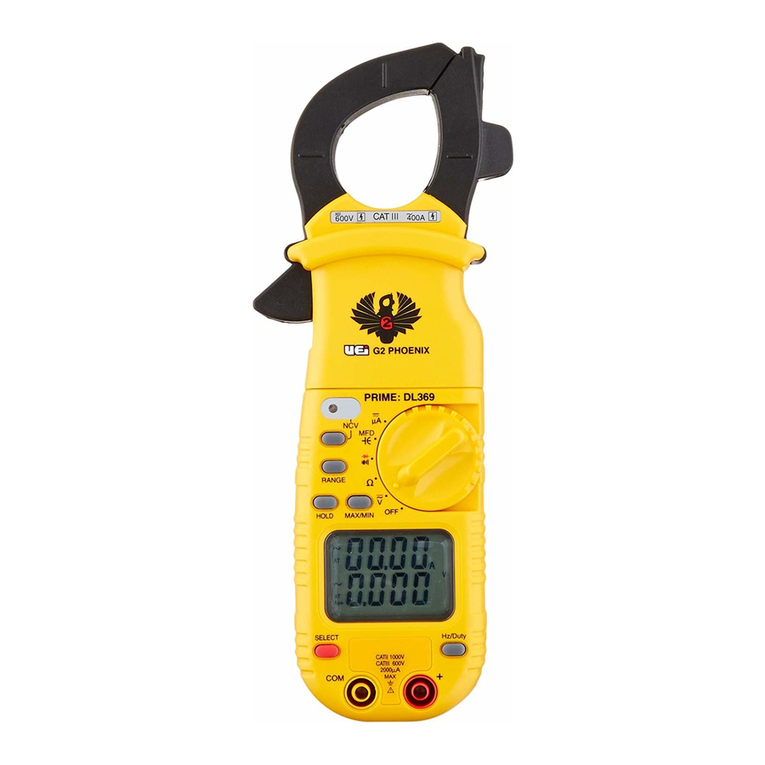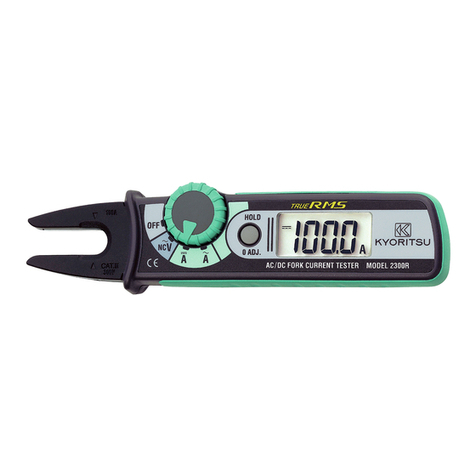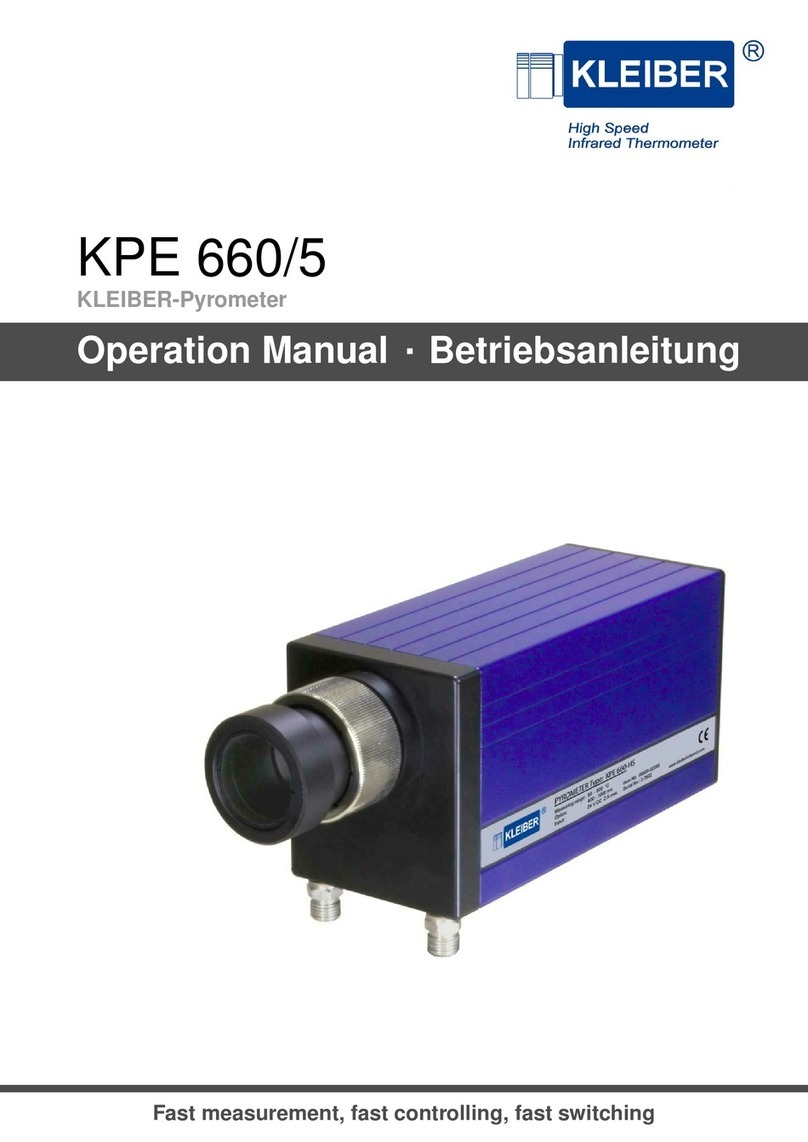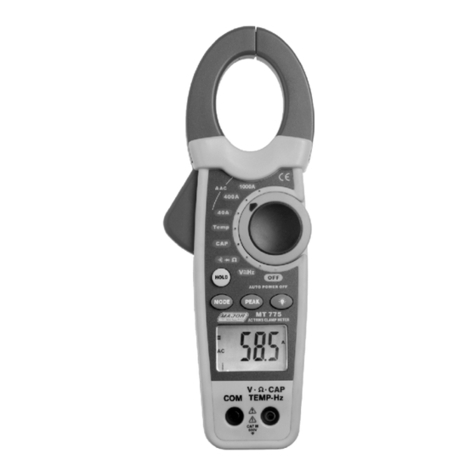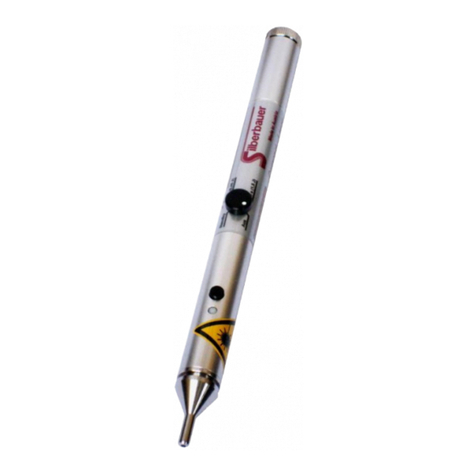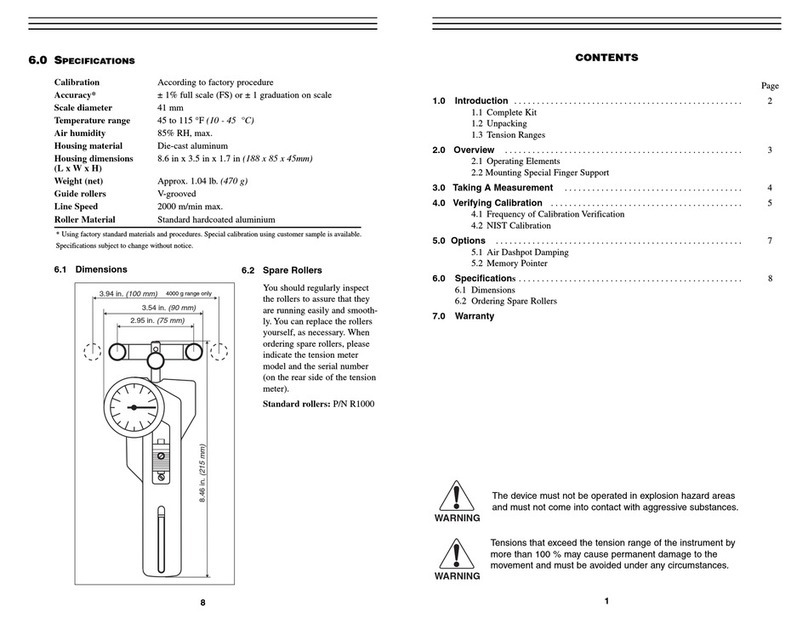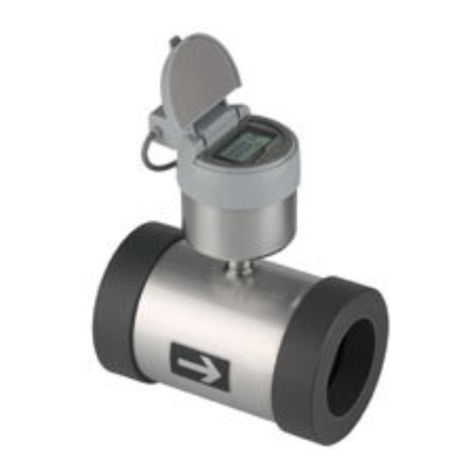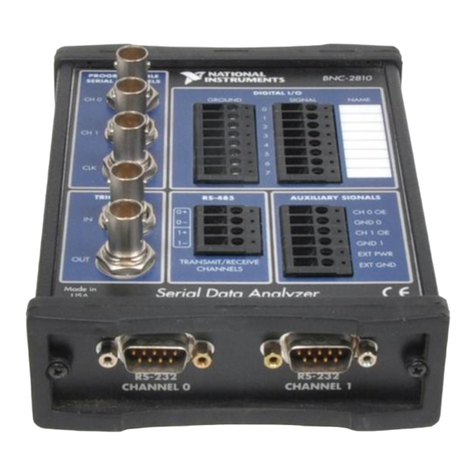FiveFish Studios VU-1MK500 User manual

VU-1MK500 VU Meter Kit
Volume Unit Meter
Simplicity Counts, Detail Matters.
No part of this document may be reproduced, either mechanically or electronically, posted online on the
Internet, in whole or in part, without the expressed, written permission of FiveFish Studios. This document is
solely provided to the kit builder of the VU-1MK500 VU Meter Kit.
Last Revision: September 18, 2011
Copyright © 2011 FiveFish Studios
www.fivefishstudios.com

VU-1mk500 VU Meter Kit
Congratulations and thank you for your purchase of the VU-1MK500 VU Meter Kit.
Countless hours has been spent in the design, manufacturing and packaging of this kit to deliver to you a
Volume Unit Meter (VU Meter) Kit at a very a!ordable price!
There are no special, expensive tools or techniques required to assemble this kit. All you need is the ability to
follow instructions, use common sense, and the confidence in knowing that YOU can do this. PLEASE READ
THIS DOCUMENT COMPLETELY BEFORE YOU ASSEMBLE YOUR VU METER KIT.
I know people sometimes don’t want to read manuals. But unlike software, there is NO UNDO for this project.
READ THIS DOCUMENT COMPLETELY FIRST. Take your time, and ask questions if you are unsure of
something. Work methodically and carefully. I promise you, you’ll be rewarded with a great working VU Meter
when you’re finished. And you’ll have pride and joy when you tell others that “Yes, I built this!”
Features, Advantages and Benefits of the VU-1MK500 VU Meter Kit
-Built-in rectifying amplifiers allow VU Meter operation by AC or DC input
-Wide display range covering –13dB to +17dB, allowing display of signals with wide dynamic range
-Regulated LED Drive current, independent of voltage supply
-High e"ciency, crystal clear Red LED indicators for VU Meter display
-Wide DC power supply voltage range… 5V to +24VDC
-Built-in voltage regulator for supply, limited to maximum of +18VDC
-Use of high quality 1% Metal Film resistors, and high-quality ceramic and electrolytic capacitors
-Easy to assemble, easy to troubleshoot design
-Each component carefully labeled, protected and packed in separate zip bags
-Low Parts Count, Very a!ordable!!!
-Displays –13dB, -7dB, 0dB, +10dB, +17dB
Basic Tools Required
A few basic tools are required to build this kit.
1. Soldering iron – adjustable temperature recommended, but not necessary. Your soldering iron must
have a sharp conical tip. I do not recommend a “flat-head, screwdriver-type” soldering iron. DO NOT
USE A SOLDERING GUN. They are usually rated at 100Watts and are overkill for this project.

2. Mini Pliers Cutter – to cut component leads, wires, strip insulation o!wires (if you don’t have a wire-
stripper tool).
3. Mini Long Nose Pliers – to bend component leads, use as a heatsink, hold components, tighten bolts.
4. Manual Solder sucker pump – sucks up solder when you made a mistake soldering components on
the PCB. Primitive operation, but it works… kind of.
5. Multitester – A simple meter/tester to measure resistance, and voltages. A digital read-out is a big
help.
6. Soldering Lead – 60/40 lead or lead-free solder
7. Magnifying glass – to see what you’re doing! Especially when soldering IC pins and the Grayhill
selector switch.
8. Clean and well-lighted work area – Lots of good lighting, clean work area. You want to be able to
leave your work-in-progress without packing everything away.
Extra Tools (Nice to have, but not required)
1. Desoldering pump – if you make a mistake, you need to pull out the component from the PCB
2. Component lead bender – bend component leads like resistors uniformly and evenly
3. PanaVise – to hold PCB while you’re working on it
4. Tweezers – to pick tiny things
5. Masking tape – to hold components on the PCB while working
6. Wire-stripper – for cutting wires and stripping its insulation

VU-1MK500 VU Meter Parts Identification and Assembly Notes
For the newbies, this is not meant to be a full tutorial about electronics. But I want you to be able to identify
components, recognize them and know what their basic functionality is.
Resistors
All resistors used in the VU Meter Kit are 1/4 watt Metal-Film type, 1% resistors.
Resistors provide resistance, and are measured in OHMS, the unit of resistance.
1,000 OHMS = 1 KOHMS (pronounced KiloOhms, where kilo = 1,000)
If you see a resistor value marked “1K”, it means 1 Kiloohm. Sometimes, you would see values written as 6K8,
or 3K3.
6K8 is also the same as writing 6.8 Kohm. The decimal point position is implied by the “K” letter.
3K3 is also the same as 3.3 Kohm, or 3,300 Ohms.
I don’t need to teach you how to read resistor color codes since all the SC-1 parts are already labeled for you.
But if you’re curious on what those bands of wonderful technicolors mean, you can go here.
http://www.samengstrom.com/nxl/10116/5_band_resistor_color_code_page.en.html
Capacitors
There are two kinds of capacitors used in the VU Meter Kit project. We’ll discuss the di!erent types here.
Ceramic Capacitors
Ceramic capacitors look like the picture on the left. On the VU Meter kit, these are
colored “yellow” and are very small in size. Ceramic capacitors are non-polarized, and
therefore it does not matter what orientation they go in.
They are rated in microfarads (abbreviated as “uf”). They also have a voltage rating
(abbreviated as “V”). In a design, the voltage rating must not be exceeded. Otherwise,
you’ll ruin the capacitor. Either short it out, or blow it open.
Capacitor parts are therefore rated with their capacitance (in microfarads, uf) and voltage… specified like this:
0.1uf 100V

Capacitance values may be expressed in microfarads (uf), nanofarad (nf) or picofarads (pf). The conversion
between these units are shown on the table above.
Electrolytic Capacitors
Electrolytic capacitors are cylindrical in construction. Unlike ceramic capacitors, electrolytic capacitors
USUALLY/MOSTLY have polarity. One side is marked with the (-) sign, also called the cathode, or negative side.
Just like ceramic capacitors, they are also measured in microfarads (uf) and have a maximum voltage rating.
WARNING: It is VERY IMPORTANT not to insert them backwards, or in the wrong polarity orientation. Doing so
may cause the capacitor to explode. Do not the let the small size fool you. Even a small capacitor can explode
with a lot of force.
All of the electrolytic capacitors used in the VU Meter Kit have polarity.
Voltage Regulator
The VU Meter Kit uses an on-board voltage regulator, limiting the supplied DC voltage to the VU Meter chip to
+18V. This means, you can connect this VU Meter Kit to power supply greater than +18V, for example: +24V
or higher. I would suggest though that keep the input voltage to the VU Meter Kit under +25V.

Trimmer
The VU Meter Kit features a 25-turn trimmer potentiometer. This is used for calibrating your VU Meter. (More
on this later.)
LED – Light Emitting Diodes
LEDs are a special kind of diode that lights up when current goes through it. We’re using low-current, high
e"ciency LEDs for the VU Meter Kit. These are crystal clear when OFF, and bright RED when turned ON. Insert
the LEDs with the longer legs on the left side, looking at the VU Meter PCB from the front.

Jumpers
The VU Meter Kit can be installed either horizontally or vertically. Normally, VU Meter movement go from LEFT
RIGHT or BOTTOM TOP direction.
That means, when the VU Meter Kit board is installed in a vertical configuration, you want your LED movement
going from BOTTOM TOP.
If the VU Meter Kit board is installed in a horizontal configuration, you want your LED movement going from
LEFT RIGHT.
Four (4) on-board jumpers are provided on the PCB to allow you to change the direction of LED movement
display. Just move ALL jumpers either to the HORZ or VERT position (for Horizontal or Vertical position
respectively).
IC Chip
The IC chip used in the VU Meter Kit is a 9-lead SIP (Single Inline Package). One side of the chip will have a V
notch. This designates where pin #1 is located. Install the IC Chip with pin #1 (V notch) on the left side of the
board (looking at the VU Meter PCB from the front view.)

Assembly and Soldering Tips
Use a clean soldering iron tip. Heat the component lead AND PCB pad at the same time, then apply the solder
to the component lead while heating both with your iron. Do not apply the solder only to the iron.
Do not remove all the parts from the zip bags until you are ready to solder them. I’ve taken the time to sort
them out; do not make a big unsorted pile out of them.
The holes on the PCB are plated through. This is also a double-sided PCB. Solder needs to make good contact
inside the holes and on both sides of the PCB. Check that some solder flowed on the other side of the PCB, or
that the holes are completely filled.
Be careful that you do not solder resistors in the wrong locations
Note the orientation of LEDs, IC chips, voltage regulator and electrolytic capacitors. There is only one correct
way to mount them. Do NOT mount electrolytic capacitors backwards. Do not mount the IC chip and voltage
regulator backwards too.
When soldering multiple-pin devices (like trimmers, headers, IC chips, voltage regulators) solder one leg/pin
first. Then check if the device is still flushed to the board, straight and not crooked. If crooked, re-heat the leg
and straighten with your fingers while the solder is still soft/melted. (DO NOT STRAIGHTEN THE PINS AFTER
THE SOLDER BECOMES HARD. You’d risk ruining the PCB or breaking the part.)
I sometimes use masking tape to hold the component in place on the board, while I solder the leads on the
other side. This is very useful when soldering resistors, and small parts, etc…
Use a magnifying glass when soldering. This prevents you from using too much solder and let’s you see what
you’re doing. Also, the IC chip has very fine pin spacing. You need good eyesight to solder all pins properly
without shorting them together.
VU-1MK500 Assembly Guide
The general guideline in electronics assembly is to solder the smallest/shortest component first (resistors),
and solder the bigger/taller components last (ceramic capacitors, electrolytic capacitors, headers, etc).
IMPORTANT NOTE: Observe the orientation of the VU Meter Chip!!!
NOTE: The photos on this Assembly guide may not exactly match the PCB you received. But the instructions
are still valid.
Follow this checklist during your construction.
STEP 1. Solder jumpers. Depending on your VU meter orientation (Horizontal or Vertical), solder the jumpers
into their correct location (marked HORZ and VERT).

STEP 2. Solder all 1/4-watt resistors and inductors to the PCB. The orientation does not matter.
Build Notes: There are some discrepancies between the silkscreen on the PCB and parts list.
PCB value 6K32 = 6K34 on parts bag
PCB value 8K = 8K2 on parts bag
STEP 3. Solder the ceramic capacitor to the PCB. The orientation does not matter. The ceramic capacitor is
located just above the voltage regulator.
STEP 4. Solder the two electrolytic capacitors. Note orientation of (-) leg. The negative leads should be as
shown in the photo below:
Note: The (-) leads are oriented on top.
STEP 5: Solder the Voltage Regulator. Note the orientation of where the “flat side” is facing.

STEP 6: Solder the IC Chip. Note orientation of pin #1. The V-notch of the chip should be on the left side.
Solder one pin first, check orientation and alignment, then solder the rest of the pins. If crooked, reheat the
first leg and straighten the chip before soldering the rest of the pins.
STEP 7: Solder the trimmer resistor. You may install the trimmer resistor on it’s side for a lower height profile.
Solder one leg first, adjust and straighten if necessary before soldering the rest of the pins.
NOTE: If you’re assembling the VU meter kit for use with the SC-1 or X12 Mic Preamp Kit, bend the Trimmer
leads and solder the Trimmer Resistor laying on it’s side.
STEP 8: Solder the (5) LEDs to the board. Bend as shown in the photo below. The long leg of the LED goes to
the left position. Try to make all the LEDs uniform in length.
NOTE: Solder the LEDS with the long leg at the bottom of the board, and in the following sequence. (see photo
above)
1. GREEN LED (TOP)
2. GREEN LED
3. GREEN LED
4. YELLOW LED
5. RED LED (BOTTOM)

STEP 9: Solder a 1.0” to 1.25” length of wire on the solder pad connections of the PCB.
VU-1MK500 Installation Guide
The VU meter only needs (3) wires to get it working. Look at header J1.
1. The first pin is labeled “IN”. This is connected to either pin2 or pin3 of the XLR output jack.
2. The second pin is labeled “GND”. Connect this to the GND of your Power Supply.
3. The third pin is labeled “V+”. Connect this to the Positive Terminal of your Power Supply.
Voltage applied to this pin must be between +5VDC to +25VDC.
If you’re using the VU meter kit with any of the FiveFish Mic Preamp Kits, solder the VU meter’s IN,
GND, and V+ wires to it’s corresponding pads on the Mic Preamp PCB.
VU-1MK500 Calibration Guide
1. Adjust trimmer resistor so that when you feed a 0dB signal to the VU Meter, the 3rd LED lamp
lights up.
For +4dBu operation, connect a signal generator to the VU meter input, 1Khz, adjust output of
Signal generator to 1.22Vrms, and adjust trimmer resistor until 3rd LED lights up.
VU-1MK500 Troubleshooting Guide
Well, hopefully you won’t need this part.
“Measure twice, cut once”… as they say. Take your time assembling the kit, don’t be in a hurry, work carefully
and methodically and you won’t need this troubleshooting guide
Problem: No lights, no LED movement. VU Meter does not work!
Check if there is power applied to the VU Meter Kit. Supply voltage must be at least 5Volts DC. Check the GND
wire is connected.
Also check that the “IN” pin on Jack J1 is connected to your XLR jack. You can connect it to either pin2 or pin3
of the XLR output jack.
Check that the LEDs were inserted in the correct orientation. Long leg soldered to the left side.
Check that you installed the jumper headers for JP1, JP2, JP3 and JP4. All jumpers must be either in the HORZ
position, or VERT position. Do not mix and match.
Check that the trimmer resistor is adjusted.

Check that you have signal coming out of your preamp/XLR jack. Make sure it is strong enough to register on
the VU Meter Kit.
VU-1MK500 PCB Component Layout Guide
VU-1MK500 VU Meter Bill of Materials
Qty
Part
Desc
1
PCB
Custom PCB
1
VREG1
78L18
5
D1,D2,D3,D4,D5
3mm LED
1
IC1
NTE1866
1
C1
0.1uf 100V
2
C2,C3
0.47uf 50V
1
R1
2K67
1
R2
6K34
1
R3
10K Trimmer
1
R4
8K2

VU-1MK500 VU Meter Schematic
No part of this document may be reproduced, either mechanically or electronically, posted online on the
Internet, in whole or in part, without the expressed, written permission of FiveFish Studios. This
document is solely provided to the kit builder of the VU-1MK500 VU Meter Kit.
Table of contents
